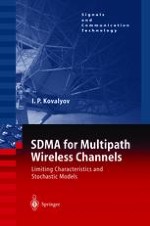2004 | Buch
SDMA for Multipath Wireless Channels
Limiting Characteristics and Stochastic Models
verfasst von: Igor P. Kovalyov
Verlag: Springer Berlin Heidelberg
Buchreihe : Signals and Communication Technology
Enthalten in: Professional Book Archive
